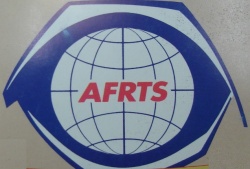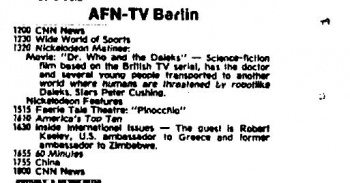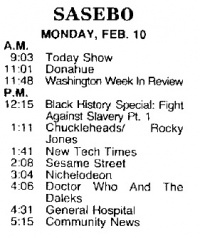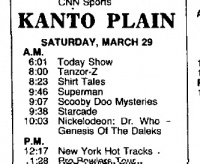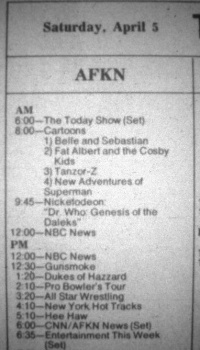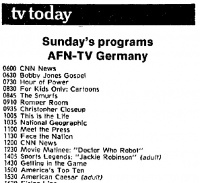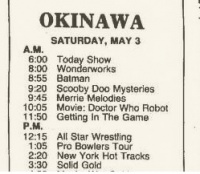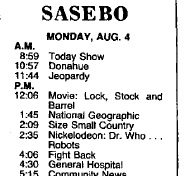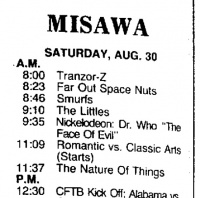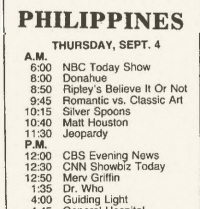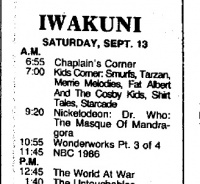Armed Forces Network
The Armed Forces Radio Service (AFRS) was established in May 1942, primarily to provide radio broadcasts to American servicemen abroad. A very basic television service began broadcasting locally from the Limestone Air Force base in Maine from 25 December 1953.
The AFRS was renamed the American Forces Radio and Television Services (AFRTS) in April 1954. This was also known as the Armed Forces Network (AFN).
By early 1955, television stations began operating from US Air Force bases overseas, such as those in Libya (the Wheelus Base), Iceland, Germany, Bermuda, Saudi Arabia (the Dhahran base), and Iran. By the mid-1960s, microwave and repeater transmitters enabled broadcasts by the AFKN to reach other parts of the Far East Network (NET) including Japan and South Korea, and eventually reaching bases in the Philippines and on islands in the Pacific Ocean.
In 1966, as the network expanded, the AFRTS Broadcast Center was established in Los Angeles; the centre was responsible for selecting and distributing all programming to the stations. By the 1980s, advancements in satellite technology meant syndication packages of the same programming could be delivered to all bases at the same time.
By the middle of 1985, with 88 radio stations and 35 land-based television outlets, plus over 1,000 facilities on American naval vessels, the AFRTS was the largest radio and television network in the world.
Although the majority of programming was American - sourced from the major commercial networks, such as ABC, CBS, FOX and NBC, as well as from PBS, CNN and other cable stations – Tom Baker episodes of Doctor Who formed part of one syndication package that was broadcast by various Armed Forces Network stations in 1986.
- NOTE: So far we have identified broadcasts of Doctor Who on the AFN station in Germany, and three Asian-based AFN stations in Japan, the Philippines and South Korea only. It is highly probable that other AFN stations in other regions of the world also aired the same run of episodes around the same time, but we have yet to locate listings for these.
Stories bought and broadcast
TOM BAKER
22 stories, equivalent of 94 episodes in omnibus "movie" format:
| 4A | Robot | 4 |
| 4B | The Sontaran Experiment | 2 |
| 4E | Genesis of the Daleks | 6 |
| 4D | Revenge of the Cybermen | 4 |
| 4F | Terror of the Zygons | 4 |
| 4H | Planet of Evil | 4 |
| 4G | Pyramids of Mars | 4 |
| 4J | The Android Invasion | 4 |
| 4K | The Brain of Morbius | 4 |
| 4L | The Seeds of Doom | 6 |
| 4M | The Masque of Mandragora | 4 |
| 4N | The Hand of Fear | 4 |
| 4P | The Deadly Assassin | 4 |
| 4Q | The Face of Evil | 4 |
| 4R | The Robots of Death | 4 |
| 4S | The Talons of Weng-Chiang | 6 |
| 4V | Horror of Fang Rock | 4 |
| 4T | The Invisible Enemy | 4 |
| 4X | Image of the Fendahl | 4 |
| 4W | The Sun Makers | 4 |
| 4Y | Underworld | 4 |
| 4Z | The Invasion of Time | 6 |
For reasons that are not clear, The Ark in Space was not part of this package of episodes. Unlike many other broadcasters, the stories were aired in the correct story order.
Transmission
JAPAN
The series was broadcast by the AFN stations in five regions across Japan:
1) Kanto Plain
In terms of the screenings covered by this profile, Kanto Plain was the first of the eight regions to air the series.
Starting from Saturday, 15 March 1986 usually around 10.00am, the 22-week run ended on 9 August 1986.
Although the 19 July episode was billed as being The Invisible Enemy, it was probably Image of the Fendahl, which would have been the next story to air in sequence.
2) Okinawa
In terms of the screenings covered by this profile, Okinawa was the fifth of the eight regions to air the series.
The programme ran from Saturday, 3 May 1986 until 27 September 1986, at various times prior to noon. One episode aired on Thursday - on 19 June. After that, the Saturday timeslot remained constant, usually around 12.20pm.
3) Misawa
In terms of the screenings covered by this profile, Misawa was the sixth of the eight regions to air the series.
The series aired from Saturday, 31 May 1986 until 25 October 1986, usually at 9.35am.
4) Iwakuni
In terms of the screenings covered by this profile, Iwakuni was the seventh of the eight regions to air the series.
The run of episodes played from Saturday, 5 July 1986 until 29 November 1986, usually starting at 9.20am.
5) Sasebo
In terms of the screenings covered by this profile, Sasebo was the last of the eight regions to air the series.
The first Peter Cushing Dalek movie, "Dr Who and the Daleks" aired on Monday, 10 February 1986 from 3.04 to 4.31pm. It's highly likely the film also aired on the other stations in Japan (it aired on AFN-TV in Germany in 1985 – see below) but we did not locate those billings.
The regular series commenced from Monday, 4 August 1986, screening usually around 2.00pm. The series then shifted to Saturdays, from 27 September until the final episode on 27 December 1986, usually playing at 10.25am.
SOUTH KOREA
- AMERICAN FORCES NETWORK - KOREA (established in South Korea in 1957).
AFN-Korea (AFNK) / AFKN operated out of Seoul (on cable channel 2); Pusan (ch 2); Taegu (ch 12); Taejon (ch 12); Kwangju (ch 13) and Wonju (ch 2).
In terms of the screenings covered by this profile, Korea was the second of the eight regions to air the series.
The series commenced on Saturday, 22 March 1986, and ended on 16 August 1986, at a timeslot of usually around 10.20am. Although the listing for Genesis of the Daleks is from 9.45am to 12.00, all subsequent 6-parters are billed for the shorter time of 10.20am to 12.00.
PHILIPPINES
In terms of the screenings covered by this profile, the Philippines was the third of the eight regions to air the series.
The series commenced on Thursday, 10 April 1986, and concluded on 4 September 1986, at various timeslots, but usually starting around 1.40pm or 2.30pm.
GERMANY
In terms of the screenings covered by this profile, Germany was the fourth of the eight regions to air the series.
The first Peter Cushing Dalek movie, "Dr Who and the Daleks" aired as the AFN-TV Berlin "Nickelodeon Matinee" on Saturday, 9 November 1985 at 1.20pm. (The film aired on other AFN stations – see Sasebo above.)
The regular series commenced on Sunday, 13 April 1986, and concluded on 7 September 1986. All episodes aired from 12.30pm until 2pm, or by 3.00pm for the 6-parters.
Listings for AFN-TV Germany place the episodes under the banner of the "Movie Matinee" rather than "Nickelodeon" as was used by the other stations.
Pertwee Stories?
BBC sales paperwork also records a sale to "West German Basic Cable" of the Jon Pertwee story The Mutants by April 1991.
The sale of that story – and presumably a package of other Pertwee episodes – may have been to this European AFN station, however we could not find any listings for Doctor Who in the early 1990s other than for those episodes screened by RTL, as is covered on the profile page for Germany.
TV listings
| ← AIRDATES ...... (CLICK ICON TO GO TO TABLE SHOWING EPISODE BREAKDOWN AND AIRDATES - N/S = story title is Not Stated) |
NOTE: The TV listings always give the billings for the series as "Nickelodeon: Dr Who" or sometimes just "Nickelodeon". We think use of that name is merely a generic Movie for Children descriptor rather than an indication that the programme is from the much later-established Nickelodeon franchise of international channels, such as Nickelodeon (Japan) and Nickelodeon (Korea).
All listings have come from the European or Japanese editions of the US Military newspaper Stars and Stripes. Story titles were given in most cases, although from September, just "Nickelodeon" was used for the Japan listings.
For the screenings in Korea, listings were also sourced and verified from the Korea Times.
On 24 May and 31 May 1986, a printing error in the Korean Times places both The Android Invasion and The Seeds of Doom in the same listing.
For some regions, for The Invasion of Time, the listing simply said "(End)".
